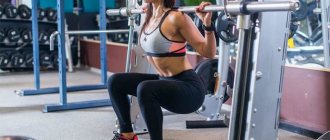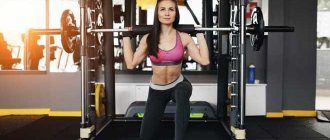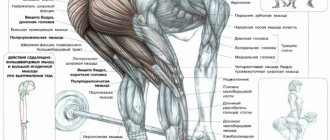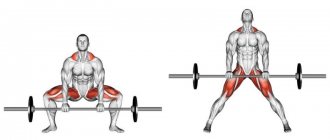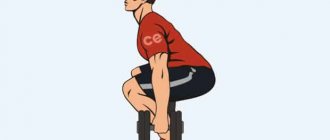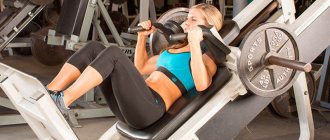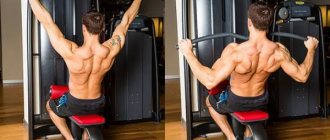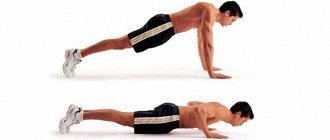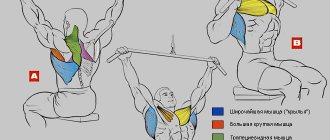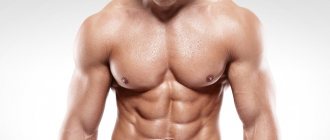For beginner athletes, it is easier to do lunges not with a barbell, but with dumbbells. It is impossible to balance with a barbell by slightly spreading and bringing your arms together, as with dumbbells.
Lunges with dumbbells can be called one of the most effective basic exercises for developing the muscles of the thighs and buttocks. Compared to squats, lunges allow you to concentrate the load on one leg and work the muscles more thoroughly.
Dumbbells in exercise
The high position of the barbell on the shoulders makes the athlete a long lever, which is difficult to keep in balance, and dumbbells in lowered hands during execution are lower than the center of gravity of the body, so it is easier to balance with them.
In case of loss of balance, it is more difficult and difficult to throw a barbell from your shoulders than to throw dumbbells by simply unclenching your fingers - lunges with a barbell require considerable dexterity, which comes with experience.
Holding a barbell on your shoulders creates a load on the spine, and if a beginner cannot keep his back straight due to a weak muscle corset and undeveloped technique, then the harmful load on the spine increases greatly. Therefore, the optimal solution for a beginning athlete is lunges with dumbbells.
Common execution errors
Although this is a relatively simple exercise, there are a number of nuances that you should pay attention to.
The main mistakes when doing lunges with dumbbells include:
- "Round back" Your back should be kept straight while performing lunges. The gaze is directed in front of you or slightly upward.
- Tilt of the body towards the front leg. As in the note above, the back should be straight, shoulders down, gaze forward.
- The knee of the working leg (front) “crawls out” beyond the line of the foot. We should not forget that the thigh and lower leg should form a right angle.
- Push with the back leg while lifting. The main load should be placed on the working leg. When performed correctly, the push is carried out by the heel of the front foot.
- Feet on the same line. With this position of the feet, it is very difficult to maintain the correct technique and maintain balance.
Muscle groups involved
Lunges are a basic leg exercise. Depending on its type and different directions: forward, backward or to the side, many muscle groups work in it.
But mainly the load falls on:
- quadriceps;
- gluteal muscles;
- thigh biceps.
Auxiliary loading:
- calf muscles;
- back straighteners;
- abdominal muscles.
Lunges are single-leg concentrated squats. The farther one leg is extended forward and the other back, the more load will be placed on the hamstrings and gluteal muscle of the front leg, and the shorter the step, the more the quadriceps will be loaded.
Features and benefits of the exercise
Lunges with dumbbells are a complex exercise, the main load of which falls on the quadriceps, hamstrings, gluteus maximus, and calf muscles. For better coordination and maintaining balance, stabilizers are connected to them - the latissimus, rhomboids, trapezius back muscles, and abdominal muscles. When an exercise is performed with weights (dumbbells, a bar), the static load falls on the shoulders, forearms, and wrists.
Essentially, these are simply successive steps from each leg with a squat on the one that is currently in front. With a wide step, the maximum load is placed on the buttocks and hamstrings. With narrow and medium, it shifts to the quadriceps. Such lunges for girls are almost a mandatory exercise. Many of them come to gyms precisely for the sake of beautiful and elastic buttocks.
Lunges with dumbbells have the following undoubted advantages:
- minimum necessary equipment (you can work in the hall or at home);
- active burning of calories;
- improvement of coordination, general endurance;
- lower risk of injury than, for example, when doing squats with a barbell;
- greater efficiency compared to leg abduction or leg lifting in exercise machines;
- the opportunity to work on increasing the volume and compaction of muscle tissue or on relief (the exercise is also suitable for men);
- variety of variations.
The main advantage is the complex technique of performing the exercise despite its apparent simplicity. To learn to coordinate the movements and position of the upper and lower halves of the body, you have to spend a lot of time and effort. Therefore, you need to start practicing with an experienced instructor; a self-mastered technique exercise may turn out to be far from quality standards.
Mastering the correct technique is important. This is the only way the movement is anatomically natural and the likelihood of injury is reduced to almost zero. When making mistakes or working with clearly unbearable weights, joints and ligaments can be seriously damaged.
This exercise allows you to work several muscle groups at once.
The main advantage is the complex technique of execution despite the apparent simplicity
It is useful to include lunges with dumbbells in both women's and men's training; this is an effective exercise for fat burning and developing endurance.
The benefits of lunges
Unlike squats with heavy weights, lunges with dumbbells are primarily aimed not at increasing muscle mass, but at creating relief. Therefore, people with insufficient volumes, in their opinion, need to combine lunges with heavy squats.
Namely:
- Lunges effectively create separation of the buttocks from the hamstrings, which, as survey statistics show, is the most important attribute of sexual attractiveness for both women and men. But do not forget about other leg exercises aimed at developing strength, mass and detail, which must be included in the training program;
- While performing lunges, in addition to tension and contraction of the muscles, it is stretched. Moreover, this applies not only to the buttocks and muscles of the back of the thighs, but also to the front. The quadriceps is stretched when the leg is pulled back at the bottom, and the hamstrings and gluteal muscles are stretched when the leg is placed forward during a squat;
- An important advantage of dumbbells over a barbell is the fact that exercises with dumbbells can be done at home, since dumbbells are easier to keep at home. In addition, dumbbells are cheaper than barbells with racks;
- As a highly dynamic movement that engages multiple stabilizer muscles, lunges are an excellent workout for developing balance and coordination.
What muscles work?
Lunges with dumbbells in your hands are an exercise for developing the hips and buttocks, but different variations of this movement load different areas of these muscles differently.
| Type of lunges | What muscles work? |
| Step forward lunges | Quadriceps, inner thighs, buttocks |
| Backward Lunges (Reverse Lunges) | Buttocks, hamstrings |
| Lunges with a side step (side lunges) | Inner thigh, quadriceps |
| Bulgarian lunges | Glutes, hamstrings, quadriceps |
| Cross lunges (cross lunges) | Quadriceps, outer thighs, buttocks |
© Makatserchyk — stock.adobe.com
Also important load distribution factors are:
- range of motion;
- step length.
If you perform each repetition through the full range of motion, touching the hamstrings of your calves each time, and pausing briefly at the lowest point of the range of motion, this increases the load on the gluteal muscles. The wider you step when performing lunges with dumbbells, the more you work your glutes and hamstrings. Shorter steps put more stress on the quadriceps, particularly the medial band.
In all lunge variations, the spinal extensors, abdominal muscles and (to a lesser extent) trapezius muscles act as stabilizer muscles.
Execution technique
- For people with vestibular disorders, it is better to perform the exercise option on the spot. For those who have a good sense of balance, lunges can be done with movement.
- The option with advancement requires more energy than the one performed on the spot. Therefore, a type of exercise in motion, simultaneously with developing muscle definition, can be used to burn excess fat.
- It is important to pay attention that the knee of the forward leg does not go beyond the level of the toe, and the angle of the maximally bent front leg is no sharper than 90° . Otherwise, there will be a harmful load on the knee joints.
- To avoid harmful stress on the spine, you must keep your back straight with your shoulder blades together. You need to look forward so as not to lose your balance.
The number of repetitions should be done 15–20 in 3–4 approaches, if the repetitions in the approach are done alternately with different legs. If you perform a set of several repetitions with one leg first, and then the other leg, you need to do 8-10 repetitions for each leg.
Tips for increasing efficiency
To get the most out of the exercise, fitness instructors advise:
- Include it in sets along with squats and deadlifts.
- To deepen the amplitude, place the supporting leg on the step platform.
- At the lowest point, fix the position for 2-3 seconds, simultaneously squeezing your buttocks as much as possible.
- Gradually increase the load (there is no point in constantly doing lunges with small dumbbells), and if you can’t work with a larger mass, try to increase the resistance using rubber bands.
- Hold dumbbells on your shoulders or in front of your chest when you can’t control your body position.
In the training program (both men's and women's complexes), lunges are usually included as the second exercise after squats or leg presses. This is due to difficulties with coordination in the process of their implementation. Not everyone succeeds in finishing a workout with lunges due to accumulating muscle fatigue.
The standard series is 3-4 sets of 12-16 repetitions on each leg with a minute interval between them. If the goal is to get rid of extra pounds, the number of repetitions increases to 20–25. First, a warm-up approach is required - 8-10 lunges without dumbbells or with minimal weight.
Knowing which muscles work when performing lunges with dumbbells, it is easy to understand why this exercise is so popular among girls. At first glance, it seems extremely simple, but in fact it requires strength, endurance, and good coordination in movement. Beginners should pay special attention to the correct technique for doing it. Only in this case the maximum load on the muscles is ensured and the desired effect is achieved.
Lunges should be included second in your training program.
Standard series - 3-4 sets of 12-16 repetitions on each leg
Lunges for men
By nature, men have a more developed upper body than women. And in women, the lower part predominates in strength.
The mass of muscles directly depends on their strength, so in women, as a rule, the buttocks and thighs are proportionally larger than the rest of the muscles, and in men, in most cases, the opposite is true.
Here, men will benefit from lunges, which help make the buttocks more convex and rounded, and refine the hamstrings, which give the legs a complete look. Lunges are also essential training for striking, moving and wrestling attacks in various combat sports.
Tips and tricks
- Before training, you need to warm up and stretch, and after training, cool down and stretch. To warm up the muscles, you can do squats without dumbbells and bend your torso forward;
- while standing or sitting on the floor are suitable for stretching the hamstrings and gluteal muscles To stretch the quadriceps, you need to grab your foot with your hand, with the knee bent as much as possible and the leg of the same name laid back. Gently pull your leg back, feeling the stretch in the quadriceps femoris muscle. You need to hold on with your other hand to maintain balance. Hold the quadriceps stretched for a few seconds and repeat for both legs several times;
- It's better to start with lunges in place. After mastering this technique and confidently performing it, you can proceed to the variation in motion. Lunges are performed either with different legs alternately, or first with one leg for the required number of repetitions, and then with the other leg;
- It is optimal to do more than one type of lunge from workout to workout, and not to fill one session with all types of exercise, but regularly, about once a month, change the options to diversify the effect on the muscles.
Working muscles
To perform this exercise effectively and correctly, you need to understand which muscles are involved. Different lunge variations shift the body's center of gravity in different ways and place emphasis on different muscle groups. At the same time they do the job:
- quadriceps (one of the two main working groups);
- hamstring biceps;
- adductor muscles.
In addition, the gluteus maximus (the bulk of the buttocks) and gluteus medius muscles, as well as auxiliary muscles: the gastrocnemius, abs and spinal erectors, also take part. The gluteal muscles are most involved during lunges . Some classifications classify lunges as a type of squats, which in principle can be argued, because the leg in front does not return to the leg behind. But the similarity of the effect from these two exercises allows us to draw this conclusion.
How to replace lunges with dumbbells?
This question may arise for at least two reasons:
- Unavailability of dumbbells. When there are no dumbbells nearby and there is no way to find them, but you need to train so as not to get out of your sports schedule, in this case you can use any weights that are the same in weight and that can be held in your hands. It is convenient to use water bottles with handles or buckets, as you can adjust their weight by pouring different amounts of water or pouring something loose.
- Contraindications for health reasons. If lunges are not recommended by a doctor due to problems with the knees, then with the doctor’s permission, the exercises can be replaced with others that load the same muscles separately, or in a slightly different way: swinging your legs in different directions with weights;
- deadlift on straight legs;
- leg press;
- leg curls;
- squats;
- exercise “gluteal bridge”;
- hyperextension.
Exercise options
Cross Lunges
The movement is similar to a curtsy, it is also called cross or side lunges, as well as scissors. Loads the gluteus maximus and quadriceps muscles. Thanks to the unique positioning of the legs, there is a good stretch of the buttocks and biceps of the thigh.
The movement technique is quite difficult for beginners, requiring a certain flexibility and the ability to maintain balance, so for the first time it is better to do “curtsies” without dumbbells.
Technique:
- If you have experience in performing the exercise, take dumbbells and hold them in your arms at your sides near your hips;
- Starting position – feet slightly wider than shoulders, toes slightly apart, back straight, gaze directed forward;
- Shift your body weight to one leg;
- Step back with the second leg and move it beyond the line of the supporting leg, the back leg moves diagonally;
- Lower yourself into a squat, the front leg should be bent at a right angle, its thigh parallel to the floor, the knee does not protrude beyond the line of the toe, the support rests on the heel;
- The back leg rests on the toe, its knee is near the floor, but does not touch it;
- Feeling a stretch in the buttocks and biceps femoris, stand up from the squat and return to the starting position;
- Do the same with the other leg or perform the required number of repetitions with one leg at once, and then several repetitions with the other leg.
Bulgarian lunges
A heavier version of the exercise. The back leg is not on the floor, but on an elevated support, and the front leg bears most of the body weight.
The knee of the front leg at the lowest point is bent at a right angle and does not protrude beyond the toe. The rear leg platform should be stable and approximately knee height. It is better to use an athletic bench.
This option is performed on the spot - no step is taken before each squat. These can be not only “Bulgarian lunges”, when placing the back leg on a hill, but also ordinary ones, when both legs are on the floor.
Walking Lunges
A variation of the exercise is performed in steps while squatting.
After the lunge, the front leg returns back to the starting position with the legs shoulder-width apart parallel to each other.
Then the stepping lunge is done with the other leg. Do the required number of repetitions and approaches.
Lunges in motion
Here, after each step, the legs do not return back to their original position, but make a linear movement as when walking. It is necessary to provide in advance the necessary free space for the lesson.
The travel distance will be approximately based on 10 large steps:
- Take dumbbells in your hands, stand straight, feet shoulder-width apart, look ahead, back straight;
- Take a step forward, pointing the toe of your front foot slightly inward;
- Lower into a squat, bending the front leg to a right angle, the knee does not protrude beyond the toe;
- The hind leg rests on the toe at the lowest point, its knee almost touches the floor;
- Smoothly push off with your back leg, shift your weight forward and take a step with your other leg;
- Do a squat with the other leg in front;
- Perform the required number of repetitions and sets.
Lunges on a bench
This exercise is also called “stepping onto a bench.”
It, like the Bulgarian lunges, is complicated, but differs in three points:
- The bench is located in front of the athlete, not behind and, accordingly, the front leg is placed on it, not the back.
- The starting position is the front leg already bent at a right angle, and in Bulgarian lunges it is straight.
- The back leg, standing on the floor, is straight in the starting position, but in Bulgarian lunges it is bent, which means that the quadriceps is stretched during the exercise.
When stepping onto the bench, you should try not to push off the floor with your back foot, but to lift the weight with your front foot. In this form, as in the “Bulgarian” version, maximum stretching of the hamstrings and gluteal muscles occurs.
Lunges with a barbell
This variety is suitable for advanced athletes who require a lot of weight, but there is no fundamental difference between it and the option with dumbbells.
Using a barbell on the shoulders requires not only a certain strength to hold a heavy projectile, developed coordination and dexterity, but also responsibility for the correct position of the back.
Rounding the spine is fraught with injury, so you need to start with a light barbell weight, and then use a reasonable weight that allows you to perform the movement technically flawlessly.
Tips on how to do lunges correctly
- When performing the exercise, do not fall forward, keep your body straight, look ahead;
- returning from the squat position to the starting position, place emphasis on the heel of the working limb, the supporting leg should be included in the work as late as possible, otherwise the load on the quadriceps will be significantly reduced;
- try to take the step as wide as possible, this will make it easier to control that the knee does not protrude onto the toe and will prevent injury to the knee joint;
- if you work out in the gym, you can increase the load by replacing dumbbells with a barbell - this will improve the effect of stabilization and coordination; this exercise with heavy dumbbells will better train the quadriceps femoris muscle;
- You will get a greater training effect if you complete all approaches first with one leg and then with the other.
Contraindications for implementation
For all its benefits for appearance, strength and health, lunges with dumbbells can still cause any harm in the following cases:
- diseases of the knee joints;
- high blood pressure;
- heart disease;
- problems with the spine, such as osteochondrosis, hernias, protrusions.
In addition to consulting a doctor before training, it is better to conduct classes under the supervision of an experienced instructor, in this case there will only be benefits.
